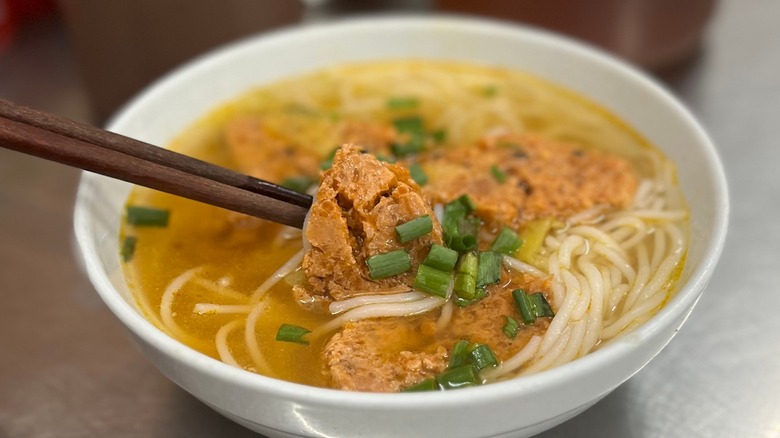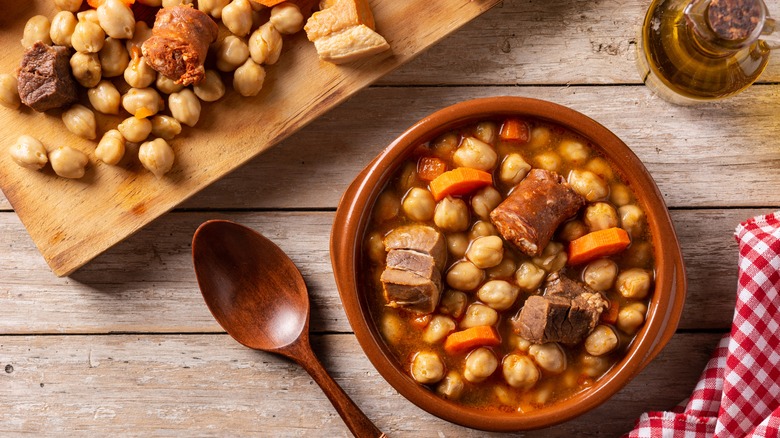Gordon Ramsay's 3 Favorite Food Destinations
Gordon Ramsay is known for his refined takes on French and British cuisine: He's spent a lot of time in France and he has two Michelin-starred restaurants there. But when it comes to traveling, this doesn't mean France is his favorite destination. In a 2023 interview with Korean food YouTuber Seungyon Cho, Ramsay named an arguably unexpected Asian country as his favorite place to eat: Laos.
Wedged between Vietnam, Cambodia, and Thailand, Laos has a cuisine that's herby, spicy, and uses plenty of tangy fermented products from noodles to meats. In countries like America, Lao cuisine has often been overshadowed by its Thai neighbors (although there's definitely some overlap between their culinary approaches), but in recent years, has become a lot easier to find, at least in areas like Los Angeles.
Ramsay describes Lao food as "off the charts," especially when he went outside of touristy areas into the countryside. He filmed an episode of his National Geographic TV series "Gordon Ramsay: Uncharted" there, learning the importance of fish from the Mekong River to the cuisine, for dishes like mok pa, herby, spiced steamed fish in banana leaves. He learned to love padek, a fermented fish product that adds some kick to soups and stews, and even "toe-biters," a water bug that he describes as tasting like a mix of lobster and crab meat. That said, he didn't end up a fan of betel nut, a stimulant that can cause dizziness.
Ramsay's next favorite: Vietnam
In his interview with Seungyon Cho, the second country Ramsay named as his favorite food destination is right next door to Laos: Vietnam. He describes the country of 100 million people as an "extraordinary melting pot of good food," adding that "there's just such a humble approach to eating good food."
Ramsay has also filmed in Vietnam, for his 2010 series "Gordon's Great Escape," focusing on various Southeast Asian countries. Despite sharing a long border with Laos, Vietnamese food isn't the same: For example, curry will crop up a lot more in Lao cuisine than Vietnamese, with Vietnamese food being somewhat less spicy; Laos also tends to use sticky rice rather than the Jasmine rice of Vietnamese food.
Some of Ramsay's Vietnamese highlights include hu tieu, a deeply-flavored pork and seafood soup, which he learned to prepare on a rickety boat in the Mekong Delta, combining the broth with banana blossoms, water spinach, and bean sprouts for crunch, and vermicelli noodles. He's also a fan of bun rieu, a sweet-spicy-sour crab noodle soup. Beyond soup, he also fell in love with barbecued duck, learning how to prepare it from scratch and marinating it in a sweet-spicy sauce. A final one of his favorites is a classic, even outside Vietnam: Goi cuon, or summer rolls. Ramsay likes them with a herby prawn filling and a spicy, garlicky dipping sauce with plenty of fish sauce.
Ramsay's final favorite: Madrid, Spain
Speaking with Seungyon Cho, Ramsay named Spain's capital city as his final favorite food destination, declaring that "there's so many exciting things going on in Madrid," and suggesting that it's a great place for him to challenge his palate. Ramsay is a bit more coy about his love for Madrid's food scene, having not filmed there for his various TV series — although he has declared Spanish cuisine as arguably better than Italian.
A likely draw is the fact that all sorts of Spanish regional specialties can be found there, from Galician-style octopus to rabo de toro, an oxtail stew from Cordoba in the south. That said, some argue that these kinds of regional specialties are best if you go directly to the source — for example, only ordering paella in Valencia, and not somewhere like Madrid.
Fortunately, Madrid has its own specialties, too: cocido madrileño is an iconic chickpea stew, stacked with plenty of meat and vegetables for a warming winter dish. Churros — fried dough sticks — sometimes dipped in chocolate are also another Madrid staple, although the origins of this sweet treat can be traced to both Mexico and China.


